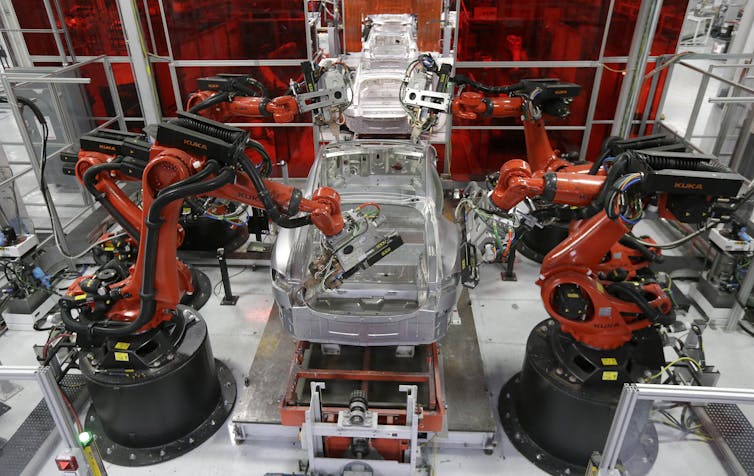Electric vehicle sales are surging. Australian sales doubled in 2022 to 3.8% of all new vehicle purchases, and were up 780% in the first two months of 2023 compared to a year ago.
In the United States, Europe and China, the market share of electric vehicles is much higher, helped by greater government support. As industry journal Automotive News put it:
The electric vehicle revolution isn’t coming – it’s already here.
And the revolution is accelerating. US moves to adopt strict new vehicle emissions standards could drive up electric vehicle sales tenfold. Old carmaking plants have already been revived.
There are bound to be flow-on effects in Australia, where the government is about to release a national electric vehicle strategy and new vehicle emission standards.
The rise of electric vehicles creates significant job opportunities, especially for nations with car-making experience – like Australia. A 2022 report by the Australia Institute’s Carmichael Centre identified it as a “once in a lifetime opportunity” to resurrect Australia’s car industry in an “environmentally and socially transformative way”.
But what’s left of vehicle manufacturing?
More than 34,000 Australians still work in the industry, making parts for global companies. Sections of the car factories – the last closed in 2017 – remain intact. “All the bones are there,” said a former site operations manager at Holden’s Elizabeth plant in 2021.
Toyota’s former plant in Altona, Victoria, even houses a “Centre of Excellence” where products for the local market are planned, designed and engineered.
If the industry is to be revived, however, political and business leaders need to act quickly and decisively. Developers have bought the old Ford sites in Broadmeadows and Geelong in Victoria, along with Holden’s Elizabeth plant in South Australia. They have plans for a mixed-use future with some industry – but no specific plans for a return to making cars.
Other challenges include finding enough workers in a tight post-COVID labour market and upgrading the skills of former car workers, plus a large number of brands limiting domestic market share of any model.
The fragmented market issue could be overcome if the industry had an export focus, particularly for valuable vehicle parts.
As for labour costs, plenty of electric vehicles – or their parts – are being made in other high-wage markets. And, as a high-wage industry, it has traditionally faced few problems recruiting workers.
So what’s happening in the US?
The US experience – where President Joe Biden has declared half of all vehicles sold there must be emissions-free by 2030 – suggests opportunities exist to convert existing facilities. Many electric vehicles are made in factories that once made conventional vehicles, reviving parts of America’s “Rustbelt” in the process.
While Elon Musk proclaims Tesla’s flagship plant in Fremont, California, to be the “factory of the future”, it is actually a former General Motors plant. It was later operated jointly by GM and Toyota. From 1962 to 2009, Fremont made conventional cars.
In 2010, when Tesla took over the facility, it rehired many former workers. Since Tesla began production in June 2012, the same buildings have been used for a highly productive assembly line.

General Motors’ compact electric vehicle, the Chevrolet Bolt, is made at a Michigan factory where workers have built 15 different models since the 1980s. They build cars with internal combustion engines alongside the Bolt, including the Chevrolet Sonic. “Everything is run down the same line, AV, EV, Sonic,” explained team leader Quentin Perea.
Japanese makers have also used existing facilities to shift into electric vehicles. Nissan’s ground-breaking Leaf is made in Smyrna, Tennessee, at a plant that has operated since the early 1980s and still makes four conventionally powered SUVs.
While not a full electric vehicle, Toyota’s best-selling RAV4 hybrid model is made in Georgetown, Kentucky. The factory has turned out petrol-fuelled cars since the 1980s. Its more than 9,000 workers now build both hybrid and conventional models.
“Electric vehicles are great,” said Dan Turke, a 50-year-old employee in Warren, Michigan. “Somebody’s still got to build them.”
Some of these factories offer unlikely comeback stories. As NBC reported, the Fremont factory “was derided as one of the industry’s worst, with reports of drinking on the job, high absenteeism, low morale and even sabotaging of cars”.
The company’s factory in Lordstown, Ohio, also has a chequered past. There was a famous strike against increased line speeds in 1972, and the factory faced closure on several occasions. Now it’s home to a landmark GM battery plant – in partnership with LG Energy.
The US experience also highlights that governments need to spend big to attract investment in electric vehicles. In early 2022, new electric car maker Rivian – backed by Amazon – announced it would build a US$5 billion plant, creating over 7,500 jobs. Georgia offered US$1.5 billion in subsidies to secure the facility.
Also in 2022, a Hyundai electric vehicle plant near Savannah, Georgia, received a government package worth US$1.8 billion. The package included free land, property tax breaks and income tax credits.
US think tank Good Jobs First estimates state and local governments have in recent years provided US$13.8 billion in incentives to land at least 51 electric vehicle and EV battery plants.
These moves reflect a longer history of subsidies to lure foreign car makers to the US. Supporters argue the long-term payoff is worth it. Car industry jobs were high-paying, strategically important and boosted the wider economy. As one US business leader said, it’s the “crown jewel in economic development”.
Australia must act decisively
In Australia, reviving the car industry will take similar bold investment and risk-taking. Another recent Carmichael Centre report concluded Australia needs a “concerted, systematic industrial policy for EV manufacturing” to take advantage of the “enormous” and “exciting” opportunities.
Australia has crucial advantages, especially as vehicle makers place high value on the availability of a workforce with industry experience. These workers are ageing, however, as are the buildings where they toiled. Time is of the essence.
Source: The Conversation





